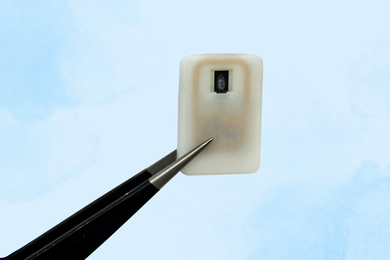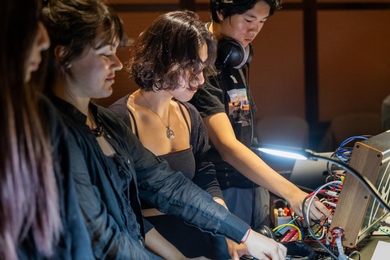The domestic plant trek for first-year LGOs spanned two weeks, seven partner companies, and more than 90 degrees — with temperatures ranging from -10 F at General Motors in Michigan to the balmy 80s at Amgen in Juncos, Puerto Rico.
LGOs are first-year students in the dual-degree MIT Leaders for Global Operations program, which offers an MBA from MIT Sloan School of Management plus an SM from one of seven MIT engineering programs to students interested in careers in operations and manufacturing.
Just getting started proved to be a lesson in logistics and airline load capacity. When the flight from Boston to Detroit was canceled due to a winter storm in the Midwest, the group of 40-plus students and staff rented vans and drove through the night amid snow and fog to attend the General Motors tour the next day.
The intrepid travelers were rewarded with visits to GM's facility in Brownstown, Mich., which assembles and tests electric lithium batteries for the Chevy Volt and Cadillac ELR, and the factory and assembly facility in Hamtramck. The group ate dinner at the GM Heritage Center, which showcases the company's 100 years of history. "So many amazing rides and styles," wrote Alex Whigham in his blog entry about the trip.
Next stop: Portland, Ore., where the group met with Nike executives and visited the manufacturing plant where the company makes "air bags" (the inflated pads in the soles of the shoes). As David Hahs recounted in his blog, the group also saw the first Air Jordan shoes and the original waffle iron that was used in making prototype shoes in the 1970s. Then the group hopped on a bus north to Washington state for stops at several Boeing facilities, including the 737 production facility in Renton, the Future of Flight Aviation Center in Everett, the Dreamliner Gallery, and the 98-acre Boeing Everett factory.
"My favorite part was the 737 facility," wrote Yalu Wu in her blog. "It was just a great example of a really well run plant that had undergone lean and really amazing to see."
After a day off in Seattle for some sightseeing and karaoke, the group headed south to Rancho Cucamonga, Calif., about an hour east of Los Angeles, and visited an Amazon fulfillment center in San Bernardino.
"The facility was so impressive — lots of automation and exciting solutions," Whigham wrote. "I continue to be impressed by Amazon's ability to improve the consumer experience."
Riding the bus to Raytheon
Then it was time for more group bonding during a seven-hour bus ride east to Raytheon Missile Systems in Tucson, Ariz. The tour included a visit to an assembly building and a "petting zoo" with models of the many different missiles the company makes.
"It was inspirational to see our class principles being applied to great detail at the level of the operator," says Albert Chan. “The workstations were designed to be ergonomic, safe, and protected against human error. I was also surprised at the detail of inspection and quality control we could see in the factory. This shows the value of our LGO education in terms of diagnosing and improving real operations."
Part of the plant trek experience after each visit was having a group of students who had been assigned to each company share their impressions and answer questions from LGO program director Don Rosenfield and Professor Shoji Shiba, a former LGO faculty member and expert on TQM (total quality management). "It was an honor for the class to have Professor Shiba on the trip with us," Lin says. "He shared with us his super-valuable insights on each company from historical, organizational, and manufacturing perspectives."
At Dell in Austin, Texas, the LGOs were treated to a Q&A with CEO Michael Dell, who discussed the company's recent re-privatization and how that is changing its business focus. They also toured the company's data center, housing hundreds of servers, and spoke with several other senior leaders about how the business operates. "Dell's supply-chain strategy is similar to what we learned in our operations and logistics classes — postponement, reduction of lead time, SKU reduction, network and node analysis, risk management, and A/B/C classification of products," says Cynthia Lin.
Pharmaceutical plant in P.R.
The last leg of the journey stretched from Texas to Puerto Rico for a visit to Amgen. Before entering the areas where the company employs both robots and human workers for packaging drugs, students donned clean-room garb, including coveralls, booties, and hairnets — including a net for the lower face of the bearded Whigham.
On the final bus ride from Amgen to the hotel, students presented Rosenfield (who is retiring from his full-time role this summer) with his own YOTO ("You Only Trek Once") T-shirt signed by everyone in the class to commemorate his last domestic plant trek as LGO program director. Then it was time for a bit of rest and relaxation, as many students took a few extra days to enjoy Puerto Rico before heading back to chilly Boston.
"Plant trek was great — we got a lot more inside access and straight talk than what we expected," Lin says. "We also weren't expecting to be so well prepared for what the companies talked to us about. They spoke in a language we wouldn't have been able to understand prior to coming to LGO. By visiting, we got a good picture of how the things we're learning at MIT can help the companies resolve challenges they face."
LGOs are first-year students in the dual-degree MIT Leaders for Global Operations program, which offers an MBA from MIT Sloan School of Management plus an SM from one of seven MIT engineering programs to students interested in careers in operations and manufacturing.
Just getting started proved to be a lesson in logistics and airline load capacity. When the flight from Boston to Detroit was canceled due to a winter storm in the Midwest, the group of 40-plus students and staff rented vans and drove through the night amid snow and fog to attend the General Motors tour the next day.
The intrepid travelers were rewarded with visits to GM's facility in Brownstown, Mich., which assembles and tests electric lithium batteries for the Chevy Volt and Cadillac ELR, and the factory and assembly facility in Hamtramck. The group ate dinner at the GM Heritage Center, which showcases the company's 100 years of history. "So many amazing rides and styles," wrote Alex Whigham in his blog entry about the trip.
Next stop: Portland, Ore., where the group met with Nike executives and visited the manufacturing plant where the company makes "air bags" (the inflated pads in the soles of the shoes). As David Hahs recounted in his blog, the group also saw the first Air Jordan shoes and the original waffle iron that was used in making prototype shoes in the 1970s. Then the group hopped on a bus north to Washington state for stops at several Boeing facilities, including the 737 production facility in Renton, the Future of Flight Aviation Center in Everett, the Dreamliner Gallery, and the 98-acre Boeing Everett factory.
"My favorite part was the 737 facility," wrote Yalu Wu in her blog. "It was just a great example of a really well run plant that had undergone lean and really amazing to see."
After a day off in Seattle for some sightseeing and karaoke, the group headed south to Rancho Cucamonga, Calif., about an hour east of Los Angeles, and visited an Amazon fulfillment center in San Bernardino.
"The facility was so impressive — lots of automation and exciting solutions," Whigham wrote. "I continue to be impressed by Amazon's ability to improve the consumer experience."
Riding the bus to Raytheon
Then it was time for more group bonding during a seven-hour bus ride east to Raytheon Missile Systems in Tucson, Ariz. The tour included a visit to an assembly building and a "petting zoo" with models of the many different missiles the company makes.
"It was inspirational to see our class principles being applied to great detail at the level of the operator," says Albert Chan. “The workstations were designed to be ergonomic, safe, and protected against human error. I was also surprised at the detail of inspection and quality control we could see in the factory. This shows the value of our LGO education in terms of diagnosing and improving real operations."
Part of the plant trek experience after each visit was having a group of students who had been assigned to each company share their impressions and answer questions from LGO program director Don Rosenfield and Professor Shoji Shiba, a former LGO faculty member and expert on TQM (total quality management). "It was an honor for the class to have Professor Shiba on the trip with us," Lin says. "He shared with us his super-valuable insights on each company from historical, organizational, and manufacturing perspectives."
At Dell in Austin, Texas, the LGOs were treated to a Q&A with CEO Michael Dell, who discussed the company's recent re-privatization and how that is changing its business focus. They also toured the company's data center, housing hundreds of servers, and spoke with several other senior leaders about how the business operates. "Dell's supply-chain strategy is similar to what we learned in our operations and logistics classes — postponement, reduction of lead time, SKU reduction, network and node analysis, risk management, and A/B/C classification of products," says Cynthia Lin.
Pharmaceutical plant in P.R.
The last leg of the journey stretched from Texas to Puerto Rico for a visit to Amgen. Before entering the areas where the company employs both robots and human workers for packaging drugs, students donned clean-room garb, including coveralls, booties, and hairnets — including a net for the lower face of the bearded Whigham.
On the final bus ride from Amgen to the hotel, students presented Rosenfield (who is retiring from his full-time role this summer) with his own YOTO ("You Only Trek Once") T-shirt signed by everyone in the class to commemorate his last domestic plant trek as LGO program director. Then it was time for a bit of rest and relaxation, as many students took a few extra days to enjoy Puerto Rico before heading back to chilly Boston.
"Plant trek was great — we got a lot more inside access and straight talk than what we expected," Lin says. "We also weren't expecting to be so well prepared for what the companies talked to us about. They spoke in a language we wouldn't have been able to understand prior to coming to LGO. By visiting, we got a good picture of how the things we're learning at MIT can help the companies resolve challenges they face."






